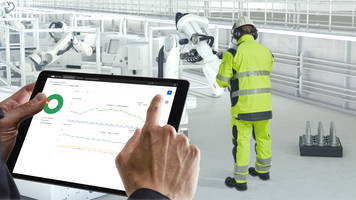New Robot Braking Distance Function Uses Motion Control Technology
Press Release Summary:

- Designed to create an exact simulation of the real-world stopping distance of a robot
- Predicts the braking behavior of a robot with its payload
- Enable users to determine ideal location of features including light curtains, safety fencing and controllers
Original Press Release:
New Braking Distance Simulator Improves Safety and Reduces Robotic Cell Footprint by up to 25 percent
ABB’s RobotStudio now offers unprecedented accuracy for calculating robot stopping distances to optimize operator safety
ABB's RobotStudio® offline programming and simulation software has been upgraded with a new virtual robot braking distance function designed to create an exact simulation of the real-world stopping distance of a robot. Enabling the robot’s braking distance to be accurately calculated, the function overcomes the need to add safety margins into cell designs, enabling space savings of up to 25 percent.
Predicting exactly where a robot will stop depends on a range of variables including speed, payload and the robot's own inertia. These factors, individually or combined, can result in the robot coming to a halt outside of its safety zone, sometimes by several meters. To compensate for the variability in stopping distances, engineers designing robot cells traditionally oversize them to allow for additional movement as the robot comes to a stop, which uses unnecessary space on the factory floor.
The new RobotStudio function uses ABB's superior motion control technology to predict the robot's movements with millimetric precision. This allows the exact movement of the robot to be simulated in RobotStudio, enabling the user to determine the correct size of the safety zone required, and the ideal location of features including light curtains, safety fencing and controllers.
For applications using ABB's SafeMove software, the data on the robot's final position can be used to determine the size of the 'green,' 'amber' and 'red' zones where the robot will either continue working, slow down or come to a halt, depending on the location of the operator. This is especially beneficial in collaborative applications where operators need to be confident that a robot has stopped before approaching it.
"Our new robot braking distance function for RobotStudio equips the user with information about a robot’s real-world movements with an unprecedented level of accuracy,” says Antti Matinlauri, Head of Product Management for ABB Robotics. “Predicting the braking behavior of a robot with its payload will help system integrators and end users save time and costs, with up to 25 percent reduction in the footprint when it comes to designing and building a robot cell or setting up a safety zone. This will help our customers optimize their processes and get the most out of their automation solutions."
As a virtual environment for programming and simulating complete robot installations, RobotStudio remains unmatched in the marketplace. By enabling cell designs to be demonstrated and tested offline, it can help shorten overall project times by allowing refinements to be made before a physical cell is built.
The virtual robot braking distance function is one of a number of downloads available for RobotStudio at https://new.abb.com/products/robotics/robotstudio/downloads.
For more information about RobotStudio, SafeMove or ABB’s range of industrial and collaborative robots, visit www.abb.com.
ABB (ABBN: SIX Swiss Ex) is a leading global technology company that energizes the transformation of society and industry to achieve a more productive, sustainable future. By connecting software to its electrification, robotics, automation and motion portfolio, ABB pushes the boundaries of technology to drive performance to new levels. With a history of excellence stretching back more than 130 years, ABB’s success is driven by about 110,000 talented employees in over 100 countries. www.abb.com
ABB Robotics & Discrete Automation is a pioneer in robotics, machine automation and digital services, providing innovative solutions for a diverse range of industries, from automotive to electronics to logistics. As one of the world’s leading robotics and machine automation suppliers, we have shipped more than 500,000 robot solutions. We help our customers of all sizes to increase productivity, flexibility and simplicity and to improve output quality. We support their transition towards the connected and collaborative factory of the future. ABB Robotics & Discrete Automation employs more than 10,000 people at over 100 locations in more than 53 countries. www.abb.com/robotics




